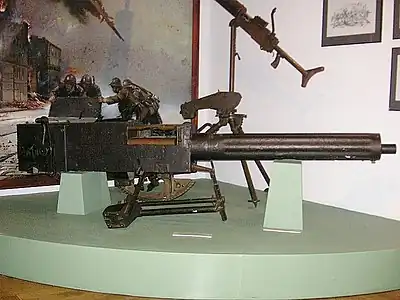| Vickers .50 machine gun | |
|---|---|
 A Vickers .50 machine gun, Polish Army Museum, Warsaw (2006) | |
| Type | Machine gun Anti-aircraft gun |
| Place of origin | United Kingdom |
| Service history | |
| In service | 1932–1954 |
| Used by | United Kingdom Ireland |
| Wars | Second World War |
| Production history | |
| Manufacturer | Vickers |
| Variants | Marks I–V[note 1] |
| Specifications (Vickers .5 Mk V) | |
| Mass | 63 pounds (29 kg) (includes 10 pounds (4.5 kg) cooling water) |
| Length | 52.4 inches (1,330 mm) |
| Barrel length | 31 inches (790 mm) |
| Cartridge | 12.7×80mm |
| Calibre | 0.5 inches (12.7 mm) |
| Rate of fire | 500–600 rounds per minute |
| Muzzle velocity | 2,540 feet per second (770 m/s) |
| Maximum firing range | Altitude: 9,500 feet (2,900 m) Range: 4,265 yards (3,900 m) |
| Feed system | belt |
The Vickers .50 machine gun, also known as the 'Vickers .50' was similar to the .303 inches (7.70 mm) Vickers machine gun but enlarged to use a larger-calibre 0.5-inch (12.7 mm) round. It saw some use in tanks and other fighting vehicles but was more commonly used as a close-in anti-aircraft weapon on Royal Navy and Allied ships, typically in a four-gun mounting (UK) or two-gun mounting (Dutch). The Vickers fired British .50 Vickers (12.7×81mm) ammunition, not the better known American .50 BMG (12.7×99mm).
Mark I
The Mark I was the development model.
Mark II, IV and V
The Mark II entered service in 1933 and was mounted in some British light tanks. Marks IV and V were improved versions and were also used on trucks in the North Africa Campaign. It was superseded for use in armoured fighting vehicles (AFVs) during the Second World War by the 15 mm (0.59 in) Besa.[1]
Mark III

The Mark III was a naval version used as an anti-aircraft weapon, mostly by the Royal Navy and allied navies in the Second World War, typically in mountings of 4 guns. It proved insufficiently powerful at short-range against modern all-metal aircraft and was superseded during the Second World War by the Oerlikon 20 mm cannon. The naval quad mount featured a 200-round magazine per barrel, which wrapped the ammunition belt around the magazine drum. Maximum rate of fire of fire was 700 rounds per minute, per gun (cyclic).[2] The four-barrel mounting had its guns adjusted to provide a spread of fire, amounting to 60 ft (18 m) wide and 50 ft (15 m) high at 1,000 yd (910 m).[1] Vickers claimed that it could fire all 800 rounds in 20 seconds and could then be reloaded in a further 30 seconds.[1] During the Second World War it was also mounted on power-operated turrets (usually a twin-gun mount) in smaller craft such as motor gunboats and motor torpedo boats.
See also
Notes
- ↑ i.e. Marks 1, 2, 3, 4, 5. Britain used Roman numerals to denote Marks (models) of ordnance until after the Second World War.
References
- 1 2 3 Williams, Anthony G. "THE .5" VICKERS GUNS AND AMMUNITION". www.quarry.nildram.co.uk. Retrieved 20 May 2013.
- ↑ DiGiulian.
Bibliography
- The Vickers Machine Gun
- Tony DiGiulian, British 0.50"/62 (12.7 mm) Mark III
- Anthony G Williams, THE .5" VICKERS GUNS AND AMMUNITION
External links